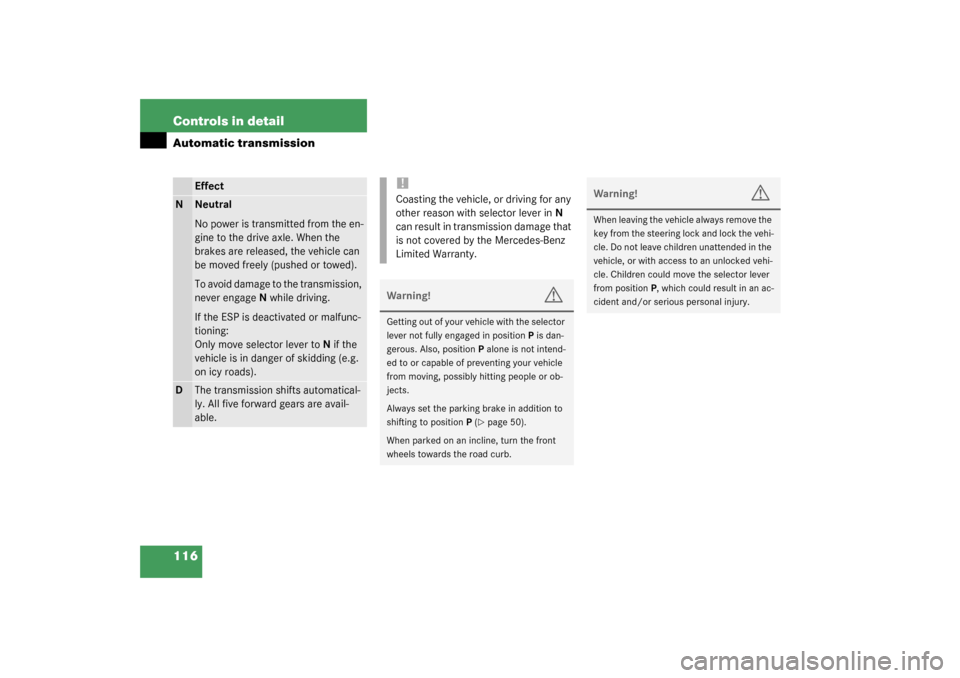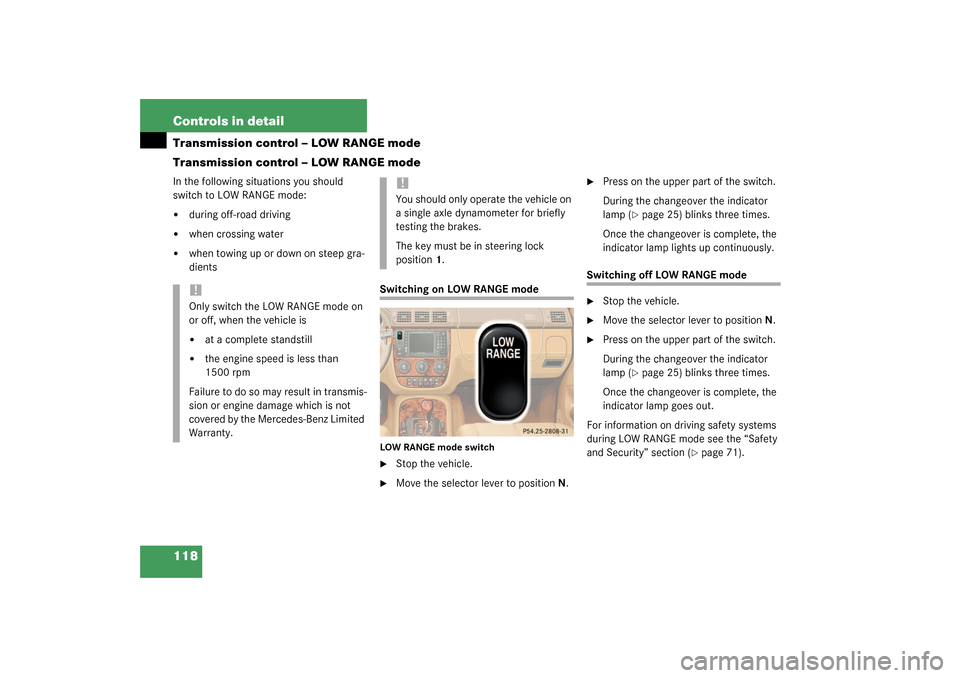Page 76 of 321

76 Safety and SecurityDriving and safety systemsLOW RANGE – ESP
During off-road driving a special low range
system for the ESP is operational with
transmission in LOW RANGE mode
(�page 118).
In the LOW RANGE mode ESP operates in
a traction improving fashion specifically
adapted for off-road driving. At speeds be-low 27 mph (45 km / h), the ESP assists in
over-/understeering, thus improving vehi-
cle traction.
Switching off the ESP
To improve the vehicle’s traction, turn off
the ESP in driving situations where it would
be advantageous to have drive wheels spin
and thus cut into surfaces for better grip
such as:
�
starting out on slippery surfaces and in
deep snow in conjunction with snow
chains
�
in sand or gravel
�
when driving off-roadWhen the ESP is turned off
�
engine torque is not limited.
�
the drive wheels can spin.
This helps the wheels cut into surfaces
for a better grip.
!The engine must be shut off when�
the parking brake is being tested on
a brake test dynamometer.
�
the vehicle is being towed with the
front axle raised.
Otherwise, the ESP will engage the
brakes and seriously damage the brake
system.
The ESP will only function properly if
you use wheels of the recommended
tire size (
�page 279).
Warning!
G
The ESP should not be switched off during
normal driving other than in the circum-
stances described below. Disabling of the
system will reduce vehicle stability in stan-
dard driving maneuvers.
!Avoid spinning of a drive wheel for an
extended period with the ESP switched
off. This may cause serious damage to
the drivetrain which is not covered by
the Mercedes-Benz Limited Warranty.iTurn ESP on immediately if the afore-
mentioned circumstances do not apply
anymore.
Page 79 of 321

79 Safety and Security
Anti-theft systems
Disarming the alarm system
The alarm system is disarmed when you
unlock your vehicle with the remote con-
trol. The turn signal lamps blink once to in-
dicate that the alarm system is
deactivated.
Canceling the alarm
To cancel the alarm:�
Switch on the ignition by turning the
key in the steering lock to position2.
or
�
Press the
Œ
or
‹
button on the
remote control.
The alarm is cancelled.Tow-away alarm, glass breakage
sensor
The tow-away alarm and the glass break-
age sensor are part of the anti-theft alarm
system.
Once the tow-away alarm is armed, a visual
and audible alarm will be triggered when
someone:�
attempts to raise the vehicle
�
breaks a window and reaches into the
passenger compartment
iIf the turn signal lamps do not blink
three times, the tow-away - glass-
breackage sensor is malfunctioning or
one of the following elements may not
be properly closed:�
a door
�
the liftgate
�
the hood
Close the respective element and lock
the vehicle again.
iThe alarm system will rearm automati-
cally again after approximately 40 sec-
onds if one of the doors or the liftgate
is not opened.
iThe tow-away protection alarm is trig-
gered, for example, if the vehicle is lift-
ed on one side.
If the alarm stays on for more than
20 seconds, an emergency call is initi-
ated automatically by the Tele Aid sys-
tem (
�page 159) provided Tele Aid
service was subscribed to and properly
activated.
Page 80 of 321
80 Safety and SecurityAnti-theft systemsArming tow-alarm and glass breakage
sensor
When you lock your vehicle, the tow-away
and glass breakage sensor alarm is auto-
matically armed.
Disarming tow-alarm and glass break-
age sensor
To prevent triggering the tow-away alarm
feature, switch off the tow-away alarm and
glass breakage sensor before towing the
vehicle, or when parking on a surface sub-
ject to movement, such as a ferry or auto
train.Vehicles with trip computer*
The buttons are located in the overhead
control panel.
1Reset button
2Mode button
3Display
4Glass breakage sensor
�
Turn key in steering lock to position1
(�page 33).
�
Press button2.
�
Return key to position0 and remove it
from the steering lock.
�
Within 30 seconds press button1 or 2.
The display shows
OFF
.
�
Exit vehicle and lock vehicle with re-
mote control (
�page 32).
The tow-away alarm and glass breakage
sensor remain switched off until the key is
inserted in steering lock and turned to
position1.
Page 81 of 321
81 Safety and Security
Anti-theft systems
Vehicles without trip computer
The buttons are located in the overhead
control panel.
1Switching off tow-away alarm and glass
breakage sensor
�
Turn key in steering lock to position1
(�page 33).
�
Press the button2.
�
Return key to position0 and remove it
from the steering lock.
�
Within 30 seconds press button1 on
the right or left side.
�
Exit vehicle and lock vehicle with re-
mote control (
�page 32).
The tow-away alarm and glass breakage
sensor remain switched off until the key is
inserted in steering lock and turned to
position1.
Page 116 of 321

116 Controls in detailAutomatic transmission
Effect
N
Neutral
No power is transmitted from the en-
gine to the drive axle. When the
brakes are released, the vehicle can
be moved freely (pushed or towed).
To avoid damage to the transmission,
never engageN while driving.
If the ESP is deactivated or malfunc-
tioning:
Only move selector lever toN if the
vehicle is in danger of skidding (e.g.
on icy roads).
D
The transmission shifts automatical-
ly. All five forward gears are avail-
able.
!Coasting the vehicle, or driving for any
other reason with selector lever inN
can result in transmission damage that
is not covered by the Mercedes-Benz
Limited Warranty.Warning!
G
Getting out of your vehicle with the selector
lever not fully engaged in positionP is dan-
gerous. Also, positionP alone is not intend-
ed to or capable of preventing your vehicle
from moving, possibly hitting people or ob-
jects.
Always set the parking brake in addition to
shifting to positionP (
�page 50).
When parked on an incline, turn the front
wheels towards the road curb.
Warning!
G
When leaving the vehicle always remove the
key from the steering lock and lock the vehi-
cle. Do not leave children unattended in the
vehicle, or with access to an unlocked vehi-
cle. Children could move the selector lever
from positionP, which could result in an ac-
cident and/or serious personal injury.
Page 117 of 321

117 Controls in detail
Automatic transmission
Accelerator position
Your driving style influences the transmis-
sion’s shifting behavior:
Less throttle Earlier upshifting
More throttle Later upshifting
Kickdown
Use kickdown when you want maximum
acceleration�
Press the accelerator past the point of
resistance.
The transmission shifts into a lower
gear.
�
Ease on the accelerator when you have
reached the desired speed.
The transmission shifts up again.
Towing a trailer
If you tow a trailer, note the following
points:�
Manually shift to a lower gear range
(4,3, 2, 1), if the transmission hunts
between gears on inclines
(�page 114).
A lower gear range and reduction of
speed reduces the change to overload
or overheat the engine.
�
At very steep inclines switch transfer
case to LOW RANGE mode
(�page 118).
For more information on trailer towing, see
the “Operation” section (
�page 192).Emergency operation (Limp Home
Mode)
If the vehicle acceleration worsens or the
transmission no longer shifts, the trans-
mission is most likely operating in limp
home mode. In this mode only 2nd gear
and reverse gear can be activated.�
Stop the vehicle.
�
Move selector lever to positionP.
�
Turn off the engine.
�
Wait at least ten seconds before re-
starting.
�
Move selector lever to position D (for
2nd gear) or R.
�
Have the transmission checked at an
authorized Mercedes-Benz Light Truck
Center as soon as possible.
Page 118 of 321

118 Controls in detailTransmission control – LOW RANGE mode
Transmission control – LOW RANGE modeIn the following situations you should
switch to LOW RANGE mode: �
during off-road driving
�
when crossing water
�
when towing up or down on steep gra-
dients
Switching on LOW RANGE modeLOW RANGE mode switch�
Stop the vehicle.
�
Move the selector lever to positionN.
�
Press on the upper part of the switch.
During the changeover the indicator
lamp (
�page 25) blinks three times.
Once the changeover is complete, the
indicator lamp lights up continuously.
Switching off LOW RANGE mode�
Stop the vehicle.
�
Move the selector lever to positionN.
�
Press on the upper part of the switch.
During the changeover the indicator
lamp (
�page 25) blinks three times.
Once the changeover is complete, the
indicator lamp goes out.
For information on driving safety systems
during LOW RANGE mode see the “Safety
and Security” section (
�page 71).
!Only switch the LOW RANGE mode on
or off, when the vehicle is�
at a complete standstill
�
the engine speed is less than
1500 rpm
Failure to do so may result in transmis-
sion or engine damage which is not
covered by the Mercedes-Benz Limited
Warranty.
!You should only operate the vehicle on
a single axle dynamometer for briefly
testing the brakes.
The key must be in steering lock
position1.
Page 139 of 321

139 Controls in detail
Loading
Loading
Loading instructions
The total load weight including vehicle oc-
cupants and luggage / cargo should not ex-
ceed the vehicle capacity weight indicated
on the certification label which can be
found on the left door pillar.
The handling characteristics of a fully load-
ed vehicle depend greatly on the load dis-
tribution. It is therefore recommended to
load the vehicle according to the illustra-
tions shown, with the heaviest items being
placed towards the front of the vehicle.Please pay attention to and comply with
the following instructions when loading the
vehicle and transporting cargo:
�
Always place items being carried
against front or rear seat backrests,
and fasten them as securely as possi-
ble.
�
The heaviest portion of the cargo
should always be kept as low as possi-
ble against front or rear seat backrests.
For additional safety when transporting
cargo while the rear seats are unoccupied,
fasten the outer seat belts crosswise into
the opposite side buckles.
Warning!
G
Always fasten items being carried as secure-
ly as possible using cargo tie-down rings and
fastening materials appropriate for the
weight and size of the load.
In an accident, during hard braking or sud-
den maneuvers, loose items will be thrown
around inside the vehicle, and can cause in-
jury to vehicle occupants unless the items
are securely fastened in the vehicle.
To help avoid personal injury during a colli-
sion or sudden maneuver, always use parti-
tion net when transporting cargo.
Never drive vehicle with the liftgate open.
Deadly carbon monoxide (CO) gases may
enter vehicle interior resulting in uncon-
sciousness and death.